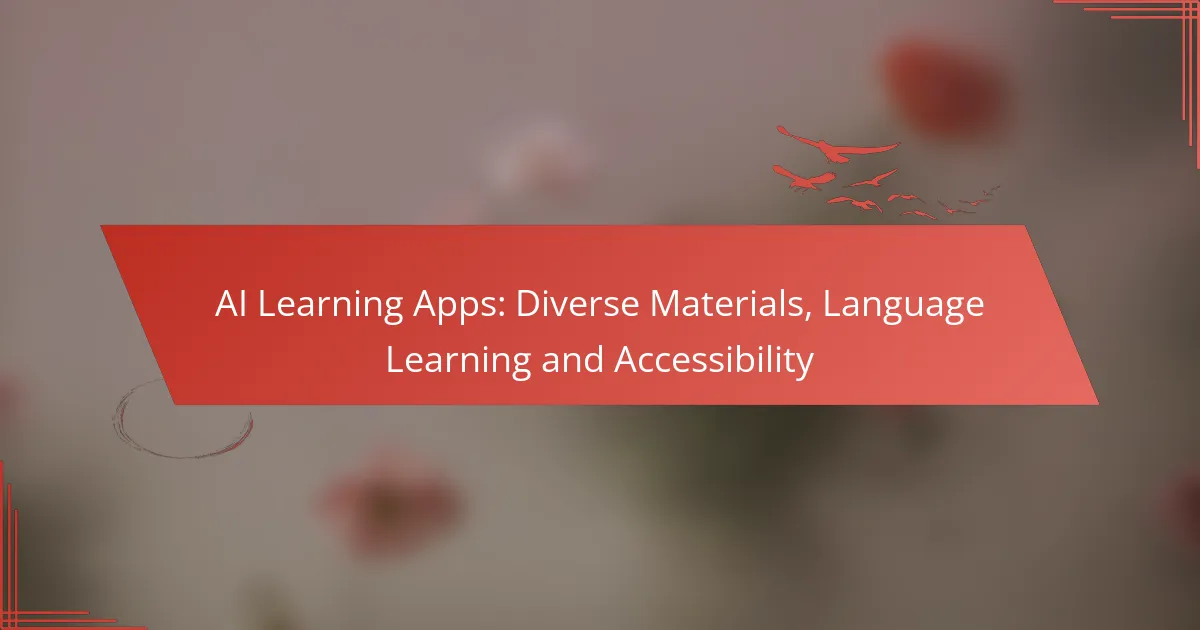Curated content plays a vital role in enhancing learning outcomes by delivering targeted materials that align with educational objectives. By utilizing effective AI tools, educators can streamline the discovery and organization of relevant information, creating a more engaging and productive learning environment. A strategic approach to content curation ensures that resources remain relevant, trustworthy, and tailored to the needs of learners.
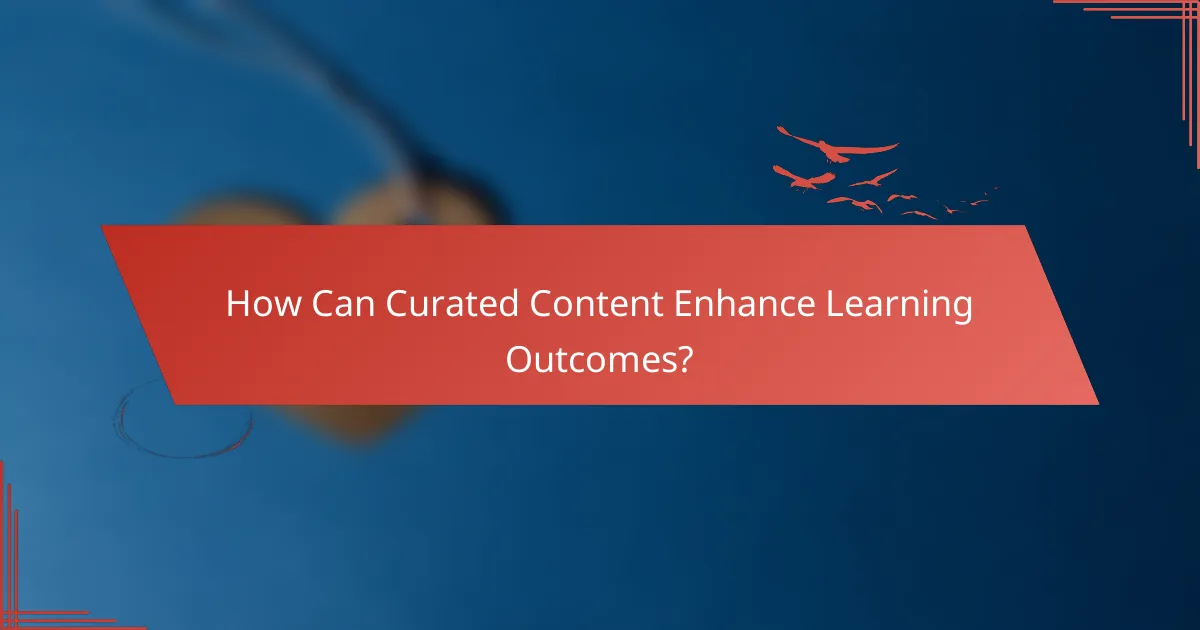
How Can Curated Content Enhance Learning Outcomes?
Curated content can significantly enhance learning outcomes by providing targeted, relevant materials that align with educational goals. This approach fosters a more engaging and effective learning environment tailored to individual needs.
Improved engagement
Curated content captures learners’ attention by presenting information in a more appealing and accessible manner. By selecting high-quality resources, educators can create a dynamic learning experience that encourages participation and interaction.
For example, incorporating multimedia elements such as videos, podcasts, and interactive quizzes can make lessons more engaging. This variety helps maintain interest and motivates learners to explore topics more deeply.
Personalized learning experiences
Curated content allows for personalization, enabling learners to access materials that suit their individual learning styles and preferences. This tailored approach can lead to a more meaningful educational experience.
Educators can use analytics to identify students’ strengths and weaknesses, then curate content that addresses specific needs. For instance, a student struggling with math might benefit from targeted practice problems and instructional videos that cater to their level.
Increased retention rates
When learners engage with curated content that resonates with them, they are more likely to retain information. This is due to the relevance and quality of the materials, which make learning more impactful.
Research suggests that retention rates can improve significantly when learners interact with diverse formats and contexts. For example, combining reading materials with hands-on activities can reinforce concepts and enhance memory retention.
Access to diverse resources
Curated content provides learners with access to a wide range of resources, including articles, videos, and case studies from various perspectives. This diversity enriches the learning experience and broadens understanding.
By exposing students to different viewpoints and methodologies, curated content fosters critical thinking and encourages them to explore subjects more comprehensively. For instance, a history lesson might include primary sources, documentaries, and scholarly articles to provide a well-rounded view of an event.
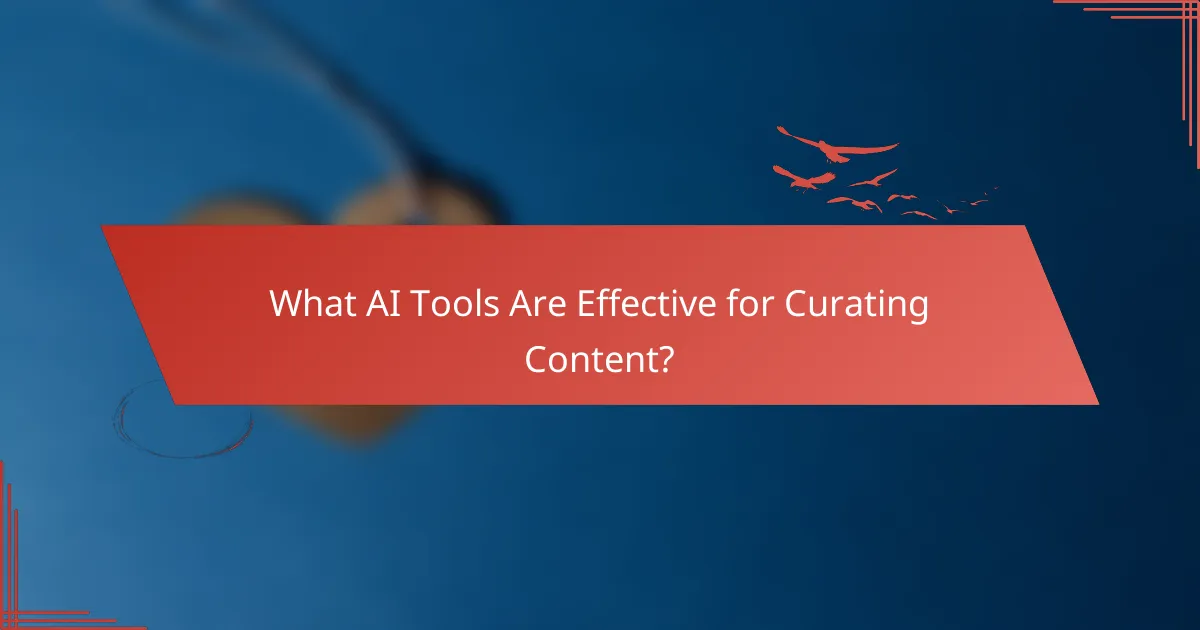
What AI Tools Are Effective for Curating Content?
Effective AI tools for curating content streamline the process of discovering, organizing, and sharing relevant information. These tools enhance productivity and ensure that users have access to high-quality resources tailored to their interests.
Feedly for content discovery
Feedly is a powerful tool for content discovery that aggregates articles from various sources based on user preferences. By using RSS feeds, it allows users to follow specific topics, blogs, and publications, making it easier to stay updated on industry trends.
To maximize Feedly’s potential, categorize your feeds into collections and prioritize sources that align with your goals. This organization helps in quickly accessing the most relevant content without sifting through irrelevant information.
Curata for automated curation
Curata specializes in automated content curation, utilizing AI to identify and recommend articles that match user-defined criteria. This tool saves time by automatically sourcing content that can be shared or repurposed, ensuring a steady flow of fresh material.
When using Curata, set clear keywords and topics to refine the content suggestions. Regularly review and adjust these parameters to enhance the relevance of the curated content, avoiding the pitfall of receiving outdated or off-topic suggestions.
ContentStudio for social media
ContentStudio is designed for social media content curation, enabling users to discover and share engaging posts across various platforms. It combines content discovery with scheduling features, allowing for efficient management of social media feeds.
To effectively use ContentStudio, leverage its analytics to identify which types of content resonate best with your audience. This data-driven approach can help refine your curation strategy and optimize engagement rates.
Evernote for organization
Evernote serves as an organizational tool for curated content, allowing users to save articles, notes, and resources in one accessible location. Its tagging and notebook features help categorize information, making retrieval straightforward.
For optimal organization, create a consistent tagging system that aligns with your content themes. Regularly review and update your saved materials to ensure that your collection remains relevant and useful for future reference.
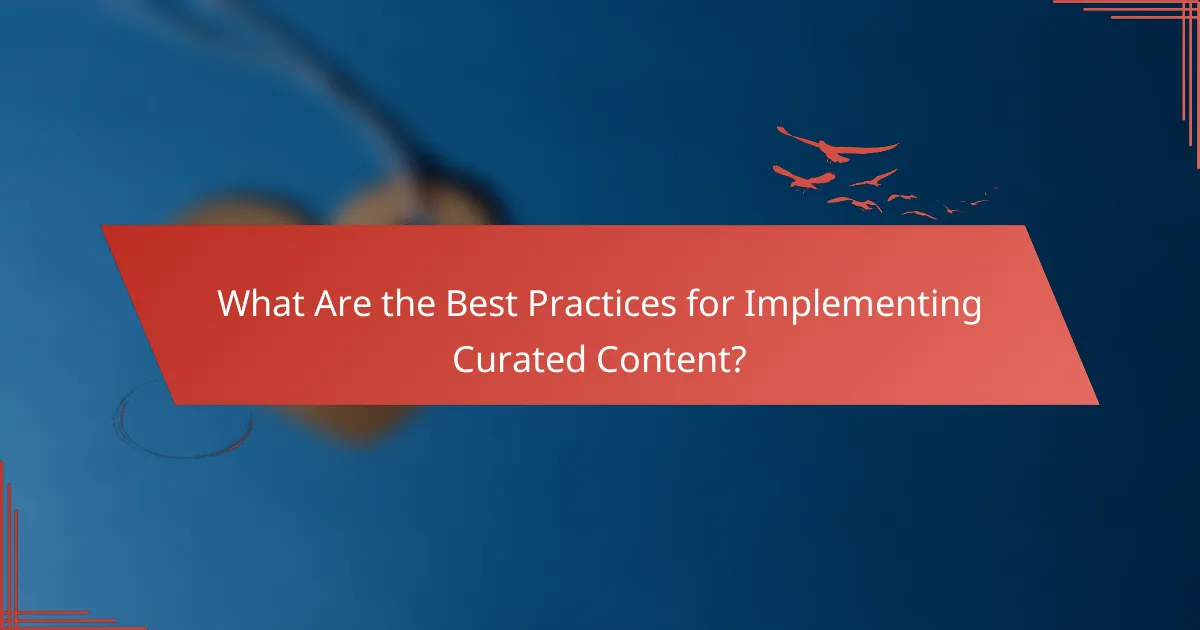
What Are the Best Practices for Implementing Curated Content?
Implementing curated content effectively requires a strategic approach that focuses on clear objectives, reliable sources, regular updates, and audience engagement. These best practices ensure that the curated material is relevant, trustworthy, and valuable to the intended audience.
Define clear objectives
Establishing clear objectives is crucial for successful curated content. Objectives guide the selection of materials and help measure the effectiveness of the curation process. Consider what you want to achieve, such as increasing user engagement, enhancing learning outcomes, or providing comprehensive resources on a specific topic.
For instance, if your goal is to improve student understanding of a subject, focus on curating content that addresses common misconceptions or highlights key concepts. This targeted approach will make your curated content more impactful.
Use reliable sources
Using reliable sources is essential for maintaining credibility in curated content. Prioritize information from established experts, reputable organizations, and peer-reviewed publications. This not only enhances the quality of your content but also builds trust with your audience.
When evaluating sources, consider factors such as the author’s qualifications, the publication’s reputation, and the date of the information. Aim to include a mix of sources, such as academic articles, industry reports, and expert interviews, to provide a well-rounded perspective.
Regularly update content
Regularly updating curated content is vital to keep it relevant and accurate. Information can change rapidly, especially in fields like technology and education. Set a schedule for reviewing and refreshing your curated materials, whether it’s monthly, quarterly, or biannually.
For example, if you curate articles on AI tools, ensure that you replace outdated resources with the latest studies or tools. This practice not only enhances the value of your content but also encourages repeat visits from your audience.
Engage with the audience
Engaging with your audience is a key component of effective curated content. Encourage feedback, questions, and discussions to foster a sense of community and involvement. This interaction can provide insights into what your audience finds valuable and what areas need improvement.
Utilize social media platforms, comment sections, or dedicated forums to facilitate engagement. Consider hosting webinars or Q&A sessions to deepen connections and gather real-time feedback on your curated content.

How Does Curated Content Support Different Learning Styles?
Curated content effectively supports various learning styles by providing tailored resources that align with individual preferences. By offering diverse formats, such as visuals, interactivity, and text, learners can engage with material in ways that resonate most with them.
Visual aids for visual learners
Visual learners benefit significantly from curated content that includes images, infographics, and videos. These aids help to illustrate complex concepts and make information more digestible. For instance, a well-designed infographic can summarize key points in a way that text alone cannot.
To enhance learning, consider using color-coded diagrams or flowcharts that highlight relationships between ideas. This approach can improve retention and understanding, as visual learners often recall information better when it is presented visually.
Interactive elements for kinesthetic learners
Kinesthetic learners thrive on hands-on experiences, making interactive elements essential in curated content. Incorporating quizzes, simulations, or interactive videos allows these learners to engage actively with the material. For example, a simulation that lets users manipulate variables can deepen understanding of scientific principles.
When curating content for kinesthetic learners, prioritize resources that encourage participation. Avoid passive formats and instead focus on tools that require action, such as drag-and-drop exercises or real-time feedback mechanisms.
Textual resources for reading/writing learners
Reading/writing learners excel with textual resources, including articles, essays, and reports. Curated content should provide well-structured written materials that allow for deep analysis and reflection. For instance, a comprehensive article with clear headings and subheadings can guide these learners through complex topics.
To support this learning style, include summaries, bullet points, and reflective questions at the end of texts. This structure not only aids comprehension but also encourages learners to engage critically with the content, enhancing their overall learning experience.
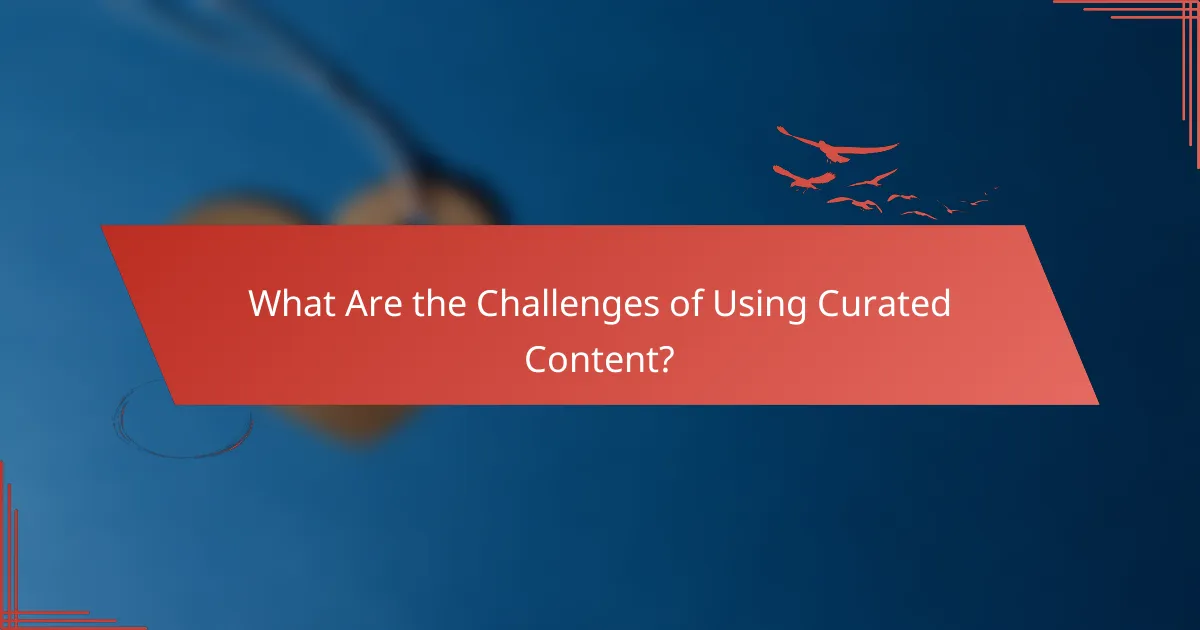
What Are the Challenges of Using Curated Content?
Using curated content presents several challenges, including maintaining quality and addressing copyright issues. These factors can significantly impact the effectiveness and legality of educational materials.
Quality control issues
Quality control is a major concern when utilizing curated content. Not all sources are equally reliable, and the accuracy of information can vary widely. Educators must carefully evaluate the credibility of each source to ensure that the content aligns with educational standards.
To mitigate quality issues, consider implementing a vetting process for sources. This can include checking the author’s credentials, reviewing the publication date, and cross-referencing with established educational materials. A checklist can help streamline this evaluation.
Copyright and licensing concerns
Copyright and licensing are critical considerations when using curated content. Many educational materials are protected by copyright, and unauthorized use can lead to legal repercussions. Understanding the licensing terms of each piece of content is essential to avoid infringement.
To navigate copyright issues, look for content that is either in the public domain or available under Creative Commons licenses. Always attribute the original creator when required and consider seeking permission for use when necessary. Familiarizing yourself with local copyright laws can also help ensure compliance.

